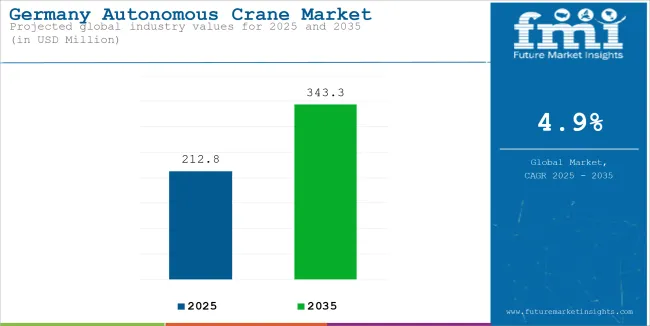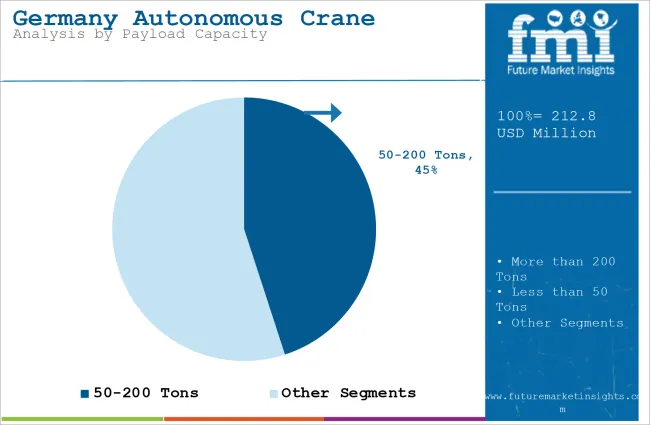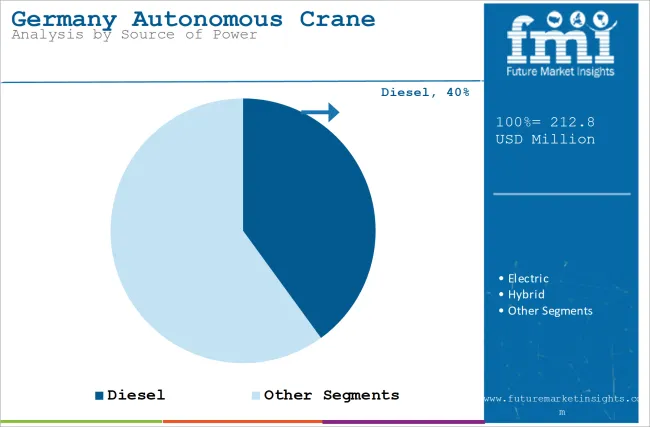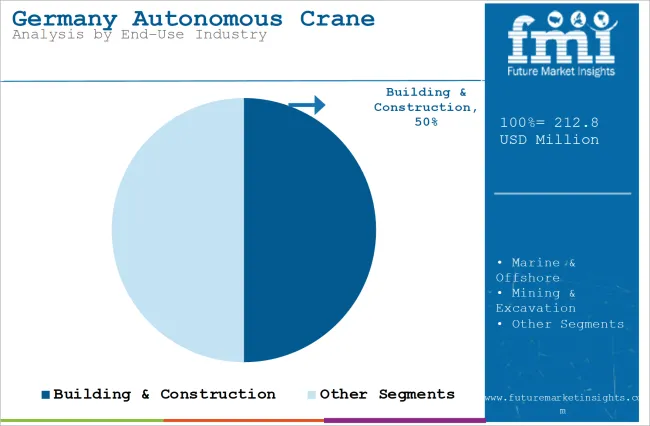The Germany autonomous crane market will experience a growth at a compound annual growth rate of 4.9% during the years from 2025 to 2035. At an estimated size of about USD 343.3 million in 2035, the overall adoption of AI, machine learning, IoT, and 5G connectivity integrated in crane systems has greatly improved operational productivity, safety, and dependability.
These innovations in technology are most applicable in industries like construction, manufacturing, and logistics, where high precision and operation efficiency are necessary.
Germany has been a leader in industrial automation and has a robust industrial base in automotive manufacturing, aerospace, and logistics. All these provide a good basis for the introduction of autonomous crane systems.
In the case of the construction and renewable energy markets, more emphasis on investments on infrastructure like road and bridge connectivity, as well as on creating wind farms and solar parks will create higher demands for autonomous cranes capable of facilitating complex lifting tasks and transporting resources with increased efficiencies.

| Attributes | Details |
|---|---|
| Projected Value by 2025 | USD 212.8 million |
| Projected Value by 2035 | USD 343.3 million |
| CAGR (2025 to 2035) | 4.9% |
Ongoing trend: Smart, Safe, and more efficient construction trends will continue growing in Germany, but more prominently is the rising demand for the use of modules and prefabrication. They will rely upon precision and accurate, on-time delivery of heavy material placements, pushing demand for Autonomous cranes even further.





Germany is known for its cutting-edge engineering and technological capabilities, making it a leader in the autonomous crane market in Europe. The country is fast adopting automation in the majority of its key sectors, like construction, logistics, and mining. Autonomous cranes, run through AI, IoT, and machine vision, redefine operational standards as they help achieve better efficiency and lower costs and safety standards.
The demand for independent cranes is driven by labor shortages and strict safety and precision requirements across large-scale German construction projects. In addition, significant investments have been made in infrastructural sectors related to renewable energy, construction, and industry, providing a further spur to market growth.
This would put Germany on a very solid position in the global autonomous crane market because of its proactive approach to sustainable development, along with ambitious targets in the construction of green infrastructure and renewable energy installations.
Governmental active support through, for example, Germany Future Mobility Fund and the strategy of Industry 4.0, supports even faster penetration with automation technologies including autonomous cranes. In its strategy to strengthen the country's economic competitiveness, automation plays an important role in the overall transformation process.
Technological Integration
Autonomous cranes in Germany are increasingly equipped with a suite of advanced technologies:
These technologies decrease the operational costs and increase the precision of tasks so that the construction process is on schedule and within budget.
Infrastructure Investment
By 2030, Germany plans to invest approximately EUR 300 billion in infrastructural investments. All this will amount to a sizeable demand for autonomous cranes, including projects like:
These projects need multi-purpose, high-performance, autonomous crane systems that are able to do complex, and large-scale, tasks. Second, the nation is placing great emphasis on renewable energy projects - such as building offshore wind farms and installing solar power generation capabilities - requiring specialty autonomous cranes for heavy lift and to assemble enormous structures in hostile and distant environments.
Workplace Safety
Renewable Energy Projects
Germany is a global leader in renewable energy, with a plan to switch to renewables by 2035. Autonomous cranes are a crucial part of the successful construction of large, complex renewable energy projects, such as:
For these projects, the demand for high-accuracy and heavy lifting cannot be fulfilled without autonomous cranes because they guarantee the safe and efficient transport and installation of heavy machinery in challenging environments.
Modular and Prefabricated Construction
Modular construction assembles its parts off-site and transfers them to the site of construction; this activity has fast grown in Germany. Highly accurate prefabricated assembly structures are achieved by using autonomous cranes. The crane type will hasten the construction speeds and cut the costs through efficient handling of large modular pieces, reduced onsite labor demands, and delay instances.
| Industry | Construction |
|---|---|
| CAGR (2025 to 2035) | 5.1% |
| Key Trends | Infrastructure projects and renewable energy drive crane demand. |
| Industry | Manufacturing |
|---|---|
| CAGR (2025 to 2035) | 4.7% |
| Key Trends | Automation in smart factories and assembly lines. |
| Industry | Logistics |
|---|---|
| CAGR (2025 to 2035) | 4.4% |
| Key Trends | E-commerce expansion boosts demand for material handling cranes. |
| Industry | Mining & Excavation |
|---|---|
| CAGR (2025 to 2035) | 4.3% |
| Key Trends | Increased use of autonomous cranes in excavation and material handling. |
Germany’s autonomous crane market is characterized by a mix of established players, innovative domestic manufacturers, and emerging startups driving the technological evolution of crane systems. The major players are:
| Date | Key Development |
|---|---|
| February 2025 | Liebherr launches a new autonomous tower crane equipped with advanced AI for building high-rise structures. |
| June 2025 | Terex announces a strategic partnership with a leading logistics firm to deploy autonomous cranes in warehouses across Germany. |
| November 2025 | Konecranes unveils an innovative mobile crane with full autonomy for the construction of offshore wind farms. |
The market is expected to reach USD 343.3 million by 2035, growing at a CAGR of 4.9%.
The construction, logistics, mining, and manufacturing industries are key drivers of autonomous crane adoption in Germany.
Key trends include the integration of AI and IoT technologies, emphasis on workplace safety, government infrastructure investment, and renewable energy projects.
Major players include Liebherr, Terex, Konecranes, and several emerging startups.
Government initiatives like the Germany Future Mobility Fund and Industry 4.0 strategy are vital for accelerating the adoption of autonomous cranes in key sectors.






Full Research Suite comprises of:
Market outlook & trends analysis
Interviews & case studies
Strategic recommendations
Vendor profiles & capabilities analysis
5-year forecasts
8 regions and 60+ country-level data splits
Market segment data splits
12 months of continuous data updates
DELIVERED AS:
PDF EXCEL ONLINE
Germany Casino Tourism Market Size and Share Forecast Outlook 2025 to 2035
Germany Sea Water Pumps Market Analysis - Size, Share, & Forecast Outlook 2025 to 2035
Germany Automotive Turbocharger Market Growth – Trends, Demand & Innovations 2025–2035
Germany Yeast Market Outlook – Share, Growth & Forecast 2025–2035
Germany Green and Bio-based Polyol Market Report – Trends, Demand & Industry Forecast 2025–2035
Germany Natural Food Color Market Growth – Trends, Demand & Innovations 2025–2035
Germany Coated Fabrics Market Report – Trends, Demand & Industry Forecast 2025–2035
Germany Barite Market Report – Trends, Demand & Industry Forecast 2025–2035
Germany Compact Construction Equipment Market Outlook – Share, Growth & Forecast 2025–2035
Germany Flare Gas Recovery System Market Trends – Growth, Demand & Forecast 2025–2035
Germany Electric Golf Cart Market Insights – Trends, Demand & Growth 2025–2035
Germany Active Spoiler Market Analysis – Share, Growth & Forecast 2025-2035
Germany Magnetic Separator Market Outlook – Growth, Trends & Forecast 2025-2035
Germany 1,4-Diisopropylbenzene Market Analysis – Demand, Growth & Forecast 2025-2035
Germany Centrifugal Pumps Market Insights – Size, Share & Industry Growth 2025-2035
Germany Travel Agency Services Market Insights – Trends, Demand & Growth 2025-2035
Germany Sports Tourism Market Trends – Size, Demand & Forecast 2025-2035
Germany Power Tools Market Growth – Trends, Demand & Forecast 2025-2035
Germany Mountain and Ski Resort Market Analysis – Size, Trends & Growth 2025-2035
Germany Outbound Travel Market Report – Size, Trends & Innovations 2025-2035

Thank you!
You will receive an email from our Business Development Manager. Please be sure to check your SPAM/JUNK folder too.
Chat With
MaRIA